[English] 日本語
 Yorodumi
Yorodumi- PDB-6loe: Cryo-EM structure of the dithionite-reduced photosynthetic altern... -
+ Open data
Open data
- Basic information
Basic information
| Entry | Database: PDB / ID: 6loe | ||||||||||||||||||
|---|---|---|---|---|---|---|---|---|---|---|---|---|---|---|---|---|---|---|---|
| Title | Cryo-EM structure of the dithionite-reduced photosynthetic alternative complex III from Roseiflexus castenholzii | ||||||||||||||||||
 Components Components |
| ||||||||||||||||||
 Keywords Keywords |  PHOTOSYNTHESIS / quinol:electron acceptor oxidoreductase PHOTOSYNTHESIS / quinol:electron acceptor oxidoreductase | ||||||||||||||||||
| Function / homology |  Function and homology information Function and homology informationmolybdopterin cofactor binding /  electron transfer activity / electron transfer activity /  oxidoreductase activity / oxidoreductase activity /  heme binding / heme binding /  membrane / membrane /  metal ion binding / metal ion binding /  plasma membrane plasma membraneSimilarity search - Function | ||||||||||||||||||
| Biological species |   Roseiflexus castenholzii (bacteria) Roseiflexus castenholzii (bacteria) | ||||||||||||||||||
| Method |  ELECTRON MICROSCOPY / ELECTRON MICROSCOPY /  single particle reconstruction / single particle reconstruction /  cryo EM / Resolution: 3.5 Å cryo EM / Resolution: 3.5 Å | ||||||||||||||||||
 Authors Authors | Shi, Y. / Xin, Y.Y. / Wang, C. / Blankenship, R.E. / Sun, F. / Xu, X.L. | ||||||||||||||||||
| Funding support |  China, 5items China, 5items
| ||||||||||||||||||
 Citation Citation |  Journal: Sci Adv / Year: 2020 Journal: Sci Adv / Year: 2020Title: Cryo-EM structures of the air-oxidized and dithionite-reduced photosynthetic alternative complex III from . Authors: Yang Shi / Yueyong Xin / Chao Wang / Robert E Blankenship / Fei Sun / Xiaoling Xu /   Abstract: Alternative complex III (ACIII) is a multisubunit quinol:electron acceptor oxidoreductase that couples quinol oxidation with transmembrane proton translocation in both the respiratory and ...Alternative complex III (ACIII) is a multisubunit quinol:electron acceptor oxidoreductase that couples quinol oxidation with transmembrane proton translocation in both the respiratory and photosynthetic electron transport chains of bacteria. The coupling mechanism, however, is poorly understood. Here, we report the cryo-EM structures of air-oxidized and dithionite-reduced ACIII from the photosynthetic bacterium at 3.3- and 3.5-Å resolution, respectively. We identified a menaquinol binding pocket and an electron transfer wire comprising six hemes and four iron-sulfur clusters that is capable of transferring electrons to periplasmic acceptors. We detected a proton translocation passage in which three strictly conserved, mid-passage residues are likely essential for coupling the redox-driven proton translocation across the membrane. These results allow us to propose a previously unrecognized coupling mechanism that links the respiratory and photosynthetic functions of ACIII. This study provides a structural basis for further investigation of the energy transformation mechanisms in bacterial photosynthesis and respiration. | ||||||||||||||||||
| History |
|
- Structure visualization
Structure visualization
| Movie |
 Movie viewer Movie viewer |
|---|---|
| Structure viewer | Molecule:  Molmil Molmil Jmol/JSmol Jmol/JSmol |
- Downloads & links
Downloads & links
- Download
Download
| PDBx/mmCIF format |  6loe.cif.gz 6loe.cif.gz | 424.8 KB | Display |  PDBx/mmCIF format PDBx/mmCIF format |
|---|---|---|---|---|
| PDB format |  pdb6loe.ent.gz pdb6loe.ent.gz | 347.5 KB | Display |  PDB format PDB format |
| PDBx/mmJSON format |  6loe.json.gz 6loe.json.gz | Tree view |  PDBx/mmJSON format PDBx/mmJSON format | |
| Others |  Other downloads Other downloads |
-Validation report
| Arichive directory |  https://data.pdbj.org/pub/pdb/validation_reports/lo/6loe https://data.pdbj.org/pub/pdb/validation_reports/lo/6loe ftp://data.pdbj.org/pub/pdb/validation_reports/lo/6loe ftp://data.pdbj.org/pub/pdb/validation_reports/lo/6loe | HTTPS FTP |
|---|
-Related structure data
| Related structure data |  0937MC  0936C  6lodC C: citing same article ( M: map data used to model this data |
|---|---|
| Similar structure data |
- Links
Links
- Assembly
Assembly
| Deposited unit | 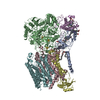
|
|---|---|
| 1 |
|
- Components
Components
-Protein , 4 types, 4 molecules ABCE
| #1: Protein | Mass: 26076.992 Da / Num. of mol.: 1 / Source method: isolated from a natural source Source: (natural)   Roseiflexus castenholzii (strain DSM 13941 / HLO8) (bacteria) Roseiflexus castenholzii (strain DSM 13941 / HLO8) (bacteria)References: UniProt: A7NJ87 |
|---|---|
| #2: Protein | Mass: 102515.883 Da / Num. of mol.: 1 / Source method: isolated from a natural source Source: (natural)   Roseiflexus castenholzii (strain DSM 13941 / HLO8) (bacteria) Roseiflexus castenholzii (strain DSM 13941 / HLO8) (bacteria)References: UniProt: A7NJ88 |
| #3: Protein | Mass: 53938.129 Da / Num. of mol.: 1 / Source method: isolated from a natural source Source: (natural)   Roseiflexus castenholzii (strain DSM 13941 / HLO8) (bacteria) Roseiflexus castenholzii (strain DSM 13941 / HLO8) (bacteria)References: UniProt: A7NJ89 |
| #5: Protein | Mass: 18252.623 Da / Num. of mol.: 1 / Source method: isolated from a natural source Source: (natural)   Roseiflexus castenholzii (strain DSM 13941 / HLO8) (bacteria) Roseiflexus castenholzii (strain DSM 13941 / HLO8) (bacteria)References: UniProt: A7NJ91 |
-Uncharacterized protein ... , 2 types, 2 molecules DF
| #4: Protein | Mass: 21070.332 Da / Num. of mol.: 1 / Source method: isolated from a natural source Source: (natural)   Roseiflexus castenholzii (strain DSM 13941 / HLO8) (bacteria) Roseiflexus castenholzii (strain DSM 13941 / HLO8) (bacteria)References: UniProt: A7NJ90 |
|---|---|
| #6: Protein | Mass: 46545.816 Da / Num. of mol.: 1 / Source method: isolated from a natural source Source: (natural)   Roseiflexus castenholzii (strain DSM 13941 / HLO8) (bacteria) Roseiflexus castenholzii (strain DSM 13941 / HLO8) (bacteria)References: UniProt: A7NJ92 |
-Non-polymers , 4 types, 12 molecules 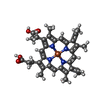

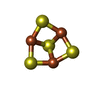




| #7: Chemical | ChemComp-HEC /  Heme C Heme C#8: Chemical |  Iron–sulfur cluster Iron–sulfur cluster#9: Chemical | ChemComp-F3S / |  Iron–sulfur cluster Iron–sulfur cluster#10: Chemical | |
|---|
-Details
| Has ligand of interest | Y |
|---|
-Experimental details
-Experiment
| Experiment | Method:  ELECTRON MICROSCOPY ELECTRON MICROSCOPY |
|---|---|
| EM experiment | Aggregation state: PARTICLE / 3D reconstruction method:  single particle reconstruction single particle reconstruction |
- Sample preparation
Sample preparation
| Component | Name: Dithionite-reduced photosynthetic alternative complex III Type: COMPLEX / Entity ID: #1-#4, #6 / Source: NATURAL |
|---|---|
| Source (natural) | Organism:   Roseiflexus castenholzii (strain DSM 13941 / HLO8) (bacteria) Roseiflexus castenholzii (strain DSM 13941 / HLO8) (bacteria) |
| Buffer solution | pH: 8 |
| Specimen | Embedding applied: NO / Shadowing applied: NO / Staining applied : NO / Vitrification applied : NO / Vitrification applied : YES : YES |
Vitrification | Cryogen name: ETHANE |
- Electron microscopy imaging
Electron microscopy imaging
| Experimental equipment |  Model: Titan Krios / Image courtesy: FEI Company |
|---|---|
| Microscopy | Model: FEI TITAN KRIOS |
| Electron gun | Electron source : :  FIELD EMISSION GUN / Accelerating voltage: 300 kV / Illumination mode: FLOOD BEAM FIELD EMISSION GUN / Accelerating voltage: 300 kV / Illumination mode: FLOOD BEAM |
| Electron lens | Mode: BRIGHT FIELD Bright-field microscopy Bright-field microscopy |
| Image recording | Electron dose: 59 e/Å2 / Detector mode: SUPER-RESOLUTION / Film or detector model: GATAN K2 SUMMIT (4k x 4k) |
- Processing
Processing
| EM software | Name: RELION / Version: 3 / Category: 3D reconstruction |
|---|---|
CTF correction | Type: PHASE FLIPPING AND AMPLITUDE CORRECTION |
| Particle selection | Num. of particles selected: 488581 |
| Symmetry | Point symmetry : C1 (asymmetric) : C1 (asymmetric) |
3D reconstruction | Resolution: 3.5 Å / Resolution method: FSC 0.143 CUT-OFF / Num. of particles: 207633 / Symmetry type: POINT |
 Movie
Movie Controller
Controller


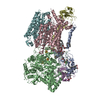
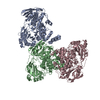

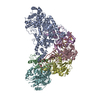


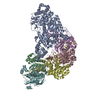

 PDBj
PDBj



















